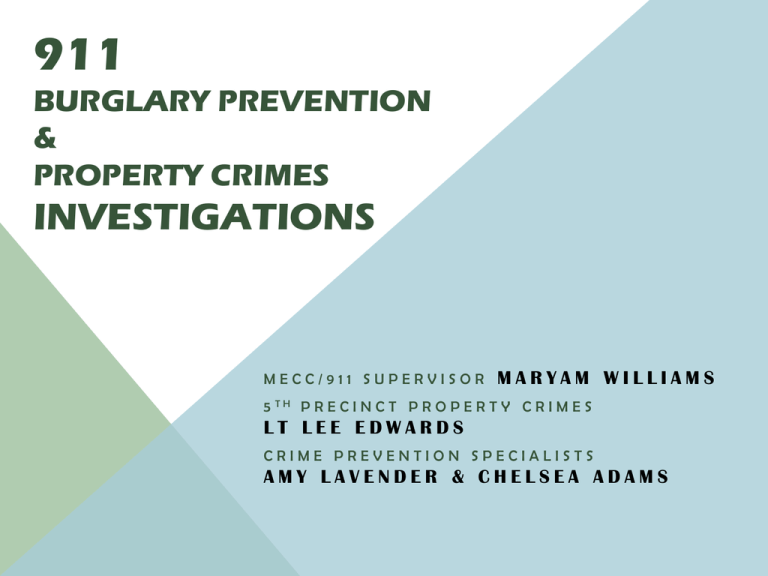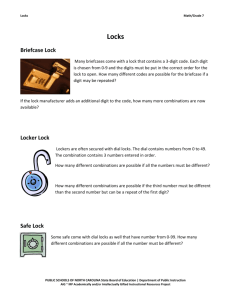911-Burglary
advertisement

911 BURGLARY PREVENTION & PROPERTY CRIMES INVESTIGATIONS MECC/911 SUPERVISOR MARYAM WILLIAMS 5 TH P R E C I N C T P R O P E R T Y C R I M E S LT LEE EDWARDS CRIME PREVENTION SPECIALISTS AMY LAVENDER & CHELSEA ADAMS NINE HELPFUL TIPS WHEN CALLING 911 Video from MECC/911 BURGLARY PREVENTION In most cases home burglary is a crime of opportunity Residents can minimize their vulnerability to opportunistic burglars by reducing or eliminating opportunity Enhancing security can be easy. Investing a little time and money now by taking preventive steps can save thousands of dollars in the long run. Watch a video of a chronic burglar describing what he looks for when determining a place to burglarize. 5 BURGLAR VIDEO Video of convicted burglar’s explanation of what he looks for when targeting homes SOURCES OF OPPORTUNITY Open, unlocked, or poorly secured doors and windows (vehicles, garages, homes, etc) Poorly secured or unsecured items like bicycles Visible valuables (in home, car etc) Unwatched or poorly lit areas with poor natural surveillance Places where criminals know no one will watch or call on suspicious activity 7 COMMON M.O.’S Spring/summertime: open or unlocked windows are easily compromised by slitting the screens, pushing open the window, and entering the home. Most residential burglaries occur during the day. Most garage burglaries occur overnight. Common entry: unlocked, open, or poorly secured door Most burglaries are a crime of opportunity. Most burglars do NOT want to confront anyone. Home invasions, as seen on TV, are very rare. 8 RECOMMENDATIONS FENCES AND LANDSCAPING LIGHTING AND NEIGHBORS • See-through fences (not privacy fences) • Dusk-till-dawn lights on entries • Trim hedges/shrubs at 3-4 feet, tree canopies at 6-7 feet • Motion lights: specify usage to neighbors • Hostile vegetation in/near large egress windows • Tell neighbors to call 911 on suspicious activity 9 LIGHTING AND GLARE Do you see the person on the bench beneath the tree? • Use covered lights to avoid glare • The human eye takes 20 minutes to adjust between light / dark • Check placement of lighting to avoid large dark spots 10 BUILDING EXTERIOR Windows : popular point of entry for burglaries. Any window 18 feet or less above ground should be considered a potential easy access point Types of Windows: • Double Hung (common; push upward; older homes have pulleys) • Jalousie/louvered (slats which tilt open; difficult to secure) • Casement (use crank to open outward) • Awning (like sideways casement; opens outward to allow breeze) • Hopper (opens inward; often in basement) • Glass Block/Brick (often in basements; very secure; allows lighting, ventilation, no opening) • Sliding (slide open like sideways double hung) 11 Picture from housekeepingchannel.com WINDOW LOCKS Double Hung Windows • The type of lock used depends on the window. Most Minneapolis homes have double hung windows. • Pin the window so it can’t open more than 6” for security. (Especially ground level windows) • Any pinning option allows for the window to open fully or close fully by removing the pin or flipping the lock Pinned double hung window opened 6” for ventilation. This is secure. 12 pinning a double hung with a nail DOUBLE HUNG WINDOW LOCKS •Locks are placed in the track or frame. • Any of these items can be found at your local hardware store. • Only one lock required per window •These are important to use in the summer/spring Shown from top to bottom: window vent stop/brass sash stop, flip lock, and nail for pinning a window. 13 INTERIOR CONTROLS Other Windows & Locks Sliding window closed, locked. Charley bar and other locks shown. Pinned sliding window opened 6” for ventilation. This is secure. Close up of a lock. Different versions of glass block/glass brick shown. Ventilation shown on the right. Glass block is the most secure window and is a great option for areas of concern in a basement. Open hopper window. Bars can be used to secure. Remember: It does NOT meet fire code for bedrooms because it does not 14 allow for egress. DOORS • • • • Frames should be heavy metal Hinges should not be exposed Outside doors should be solid If there are windows within 40” of the lock, consider: double or triple pane windows shatter-resistant window film or double cylinder lock Sliding doors should have flathead screws installed in the upper track and a charley bar to prevent the lifting and removal of the door panel. To increase the safety of your door, consider a high security strike plate. 15 ANATOMY OF A DOOR • Deadbolts are recommended. • Check to ensure: • the throw (bolt) is at least 1” • Screws on the strike plate are a least 3” and extend into the stud. 16 DOUBLE VS SINGLE CYLINDER DEADBOLT SINGLE CYLINDER • Most commonly recommended lock DOUBLE CYLINDER • Extra security for doors with glass • Safety hazard in case of fire • Not recommended for homes with elderly, children, or vulnerable adults 17 PROPERTY CRIMES INFORMATION How are property crimes investigated in Fifth Precinct? Report routed to unit Officer report Lt reviews for evidence Outcome Not assigned Assigned investigated charged Can assign with evidence Questions? Maryam Williams Amy Lavender MECC/911 Supervisor (citywide) Crime Prevention Specialist 5th Precinct 612.348.2345 Maryam.Williams@minneapolismn.gov 612.673.5407 Amy.Lavender@minneapolismn.gov Lt Lee Edwards Chelsea Adams Property Crimes Lieutenant 5th Precinct 612.673.5592 Lee.Edwards@minneapolismn.gov Crime Prevention Specialist 5th Precinct 612.673.2819 Chelsea.Adams@minneapolismn.gov 20











